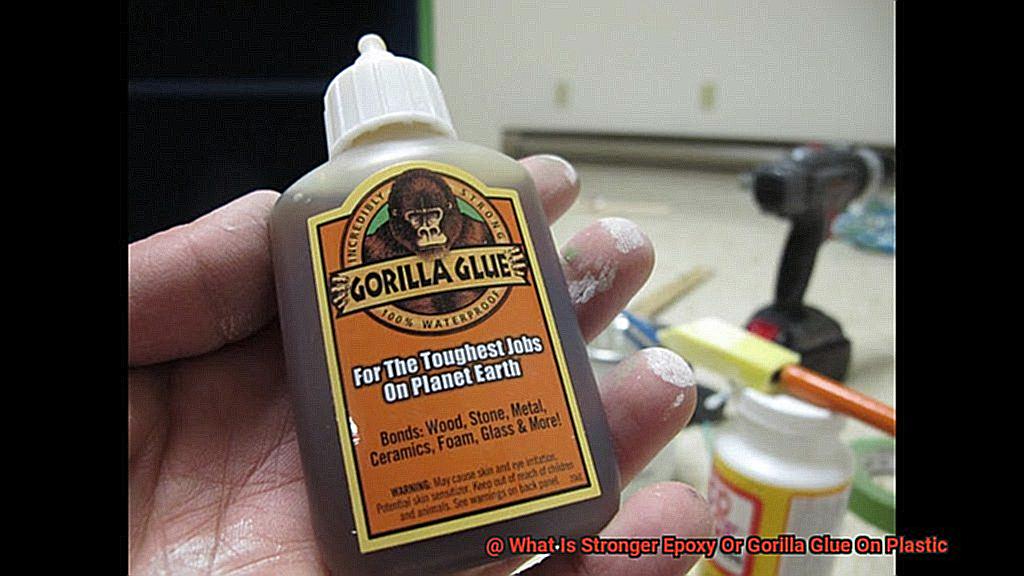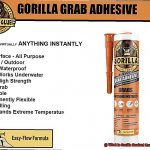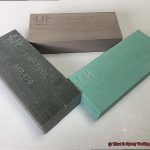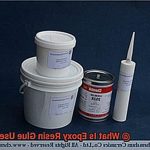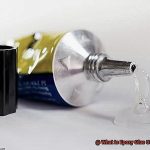Have you ever found yourself in a sticky situation where you need to fix something quickly, but you’re not sure which adhesive to use? Fear not, my friend. Two of the most popular choices are superglue and epoxy. But the question remains: which one is stronger? This debate has been ongoing for quite some time now. In this blog post, we’ll dive into the nitty-gritty differences between superglue and epoxy and determine once and for all which one reigns supreme.
Superglue and epoxy are both versatile adhesives that dry quickly and bond a wide range of surfaces. Superglue, also known as cyanoacrylate adhesive, is commonly used for small repairs like fixing broken ceramics or plastic toys. On the other hand, epoxy is a two-part adhesive known for its strength and durability. It’s perfect for bonding metal, wood, glass, and even plastic.
But here’s where things get interesting – which one is stronger? Well, it’s not a simple answer as it depends on what materials you’re bonding together and the environment you’re working in. That’s why we’ve taken on the task of examining their strengths and weaknesses in this blog post. So sit back with your favorite cup of joe and let’s find out once and for all – superglue or epoxy: which one takes home the crown for strongest adhesive?
Advantages of Using Superglue
Contents
- 1 Advantages of Using Superglue
- 2 Advantages of Using Epoxy
- 3 Types of Superglue and Epoxy
- 4 How to Choose the Right Glue for Your Project
- 5 Comparing Strength: Superglue vs Epoxy
- 6 Specialty Glues and Their Uses
- 7 Tips for Working with Superglue and Epoxy
- 8 Common Mistakes to Avoid When Using Glues
- 9 Conclusion
Its fast-drying and strong bonding properties make it a popular choice for various applications. Let’s delve into the advantages of using superglue.
Versatility
Superglue can bond almost any material, from plastic and metal to wood and ceramic. This makes it an adaptable adhesive for a wide range of projects. Whether you need to fix a broken vase or assemble a model kit, superglue has got your back.
Waterproof and Heat Resistant
Superglue is also waterproof and heat-resistant, making it an ideal adhesive for outdoor projects or items that will be exposed to moisture or high temperatures. It won’t break down or lose its strength, ensuring your project stays intact.
Fills gaps and cracks
The ability of superglue to fill gaps and cracks in materials gives it an edge over other adhesives. This feature ensures that the bond is strong and long-lasting, making it an excellent option for repairing broken ceramics or glassware.
Ease of Use
Superglue is incredibly easy to use, even for beginners. Simply apply a small amount of glue to one surface, press the two surfaces together, and hold them in place for a few seconds. The glue dries quickly, usually within seconds, making it a great option for time-sensitive projects.
Affordability
The affordability of superglue is another advantage that makes it a convenient choice for DIY projects or quick repairs around the house. It’s readily available at most hardware stores and online retailers, so you won’t have to break the bank to get your hands on it.
Advantages of Using Epoxy
Epoxy is a high-strength adhesive that has become a go-to choice for many applications due to its numerous advantages over other adhesives, such as superglue. From exceptional bonding strength to durability and resistance to heat, chemicals, and water, epoxy offers a range of benefits that make it stand out.
One of the most significant advantages of epoxy is its unbeatable bonding strength. This adhesive sets quickly and creates a bond that can withstand significant force and pressure, making it ideal for applications where a strong and long-lasting bond is required. Whether you’re working on metal, wood, plastic, glass, or other materials, epoxy’s bonding strength ensures a reliable and robust bond.
In addition to its exceptional bonding strength, epoxy is highly durable and resistant to wear and tear. Once cured, it can withstand high levels of stress and strain without cracking or breaking. This makes it ideal for use in high-traffic areas or equipment that undergoes frequent use, where durability is critical.
Epoxy’s resistance to heat, chemicals, and water is another significant advantage. It can withstand exposure to extreme temperatures or harsh chemicals without losing its adhesive properties. It’s also highly resistant to moisture and can be used in wet or damp environments without compromising its adhesive properties. Thus, it’s an excellent choice for applications in harsh environments or where exposure to moisture is expected.
Moreover, epoxy is versatile and easy to use. It comes in a range of formulations that can be tailored to specific applications and requirements. It can be applied to various surfaces with ease, making it a go-to adhesive for different projects.
Types of Superglue and Epoxy
Superglue and epoxy are versatile adhesives that can be used to bond various materials. However, not all superglue or epoxy products are created equal. There are different types of superglue and epoxy available in the market, each with its unique properties and strengths.
Superglue comes in three main types
ethyl cyanoacrylate, methyl cyanoacrylate, and butyl cyanoacrylate. Ethyl cyanoacrylate is the most common type and is known for its fast-drying and strong bonding properties. It is ideal for non-porous surfaces like metal and plastic. Methyl cyanoacrylate has a longer drying time and is better for porous materials like wood and ceramics. Butyl cyanoacrylate is the slowest-drying type but offers great flexibility and is often used in medical applications.
When it comes to epoxy, there are two main types
one-part and two-part. One-part epoxy is premixed and ready to use but has a limited shelf life. It is also not as strong as two-part epoxy. Two-part epoxy requires mixing before use and offers a stronger bond with greater durability. It is often used in industrial applications such as construction, automotive, and aerospace.
Specialized types of superglue and epoxy are also available for specific uses such as metal bonding or plastic bonding. For example, metal bonding superglue contains metal particles that enhance its strength when bonding metals.
Superglue comes in various forms such as liquid, gel, and spray. Gel superglue is thicker than liquid superglue and can be used on vertical surfaces or for filling gaps. Spray superglue is convenient for hard-to-reach areas or bonding larger surfaces.
Epoxy also comes in different types such as fast-setting and slow-setting. Fast-setting epoxy is ideal for quick repairs while slow-setting epoxy provides more time for adjusting the bond before it sets.
How to Choose the Right Glue for Your Project
Choosing the Right Glue for Your Project: A Comprehensive Guide
Starting a new project can be exciting, but choosing the right glue for the job can be overwhelming. With so many types of glue available, it’s important to take a few factors into consideration to ensure your project stays together for the long haul. Here are five sub-sections to consider when choosing the right glue for your project:
Materials:
The materials you’re working with should be the first consideration when choosing a glue. Different glues work better on different surfaces such as wood, plastic, metal, or fabric. Some glues are versatile and work well on a variety of surfaces, while others are designed for specific materials. It’s important to choose a glue that is compatible with the materials you’re bonding to ensure a strong and lasting bond.
Strength and Durability:
The strength and durability required for your project should also be taken into account. If you need a strong bond that can withstand heavy use or extreme conditions, then epoxy may be the better choice. Epoxy is known for its exceptional strength and resistance to water and heat. However, if you need a quick fix or a temporary bond, then superglue may be the better option. Consider the level of stress your bond will undergo and choose a glue accordingly.
Drying Time and Curing Process:
The drying time and curing process of the glue is also an important factor. Some glues dry quickly but require time to fully cure and reach maximum strength. Others may take longer to dry but reach full strength immediately. Consider how much time you have to work on your project and how long you’re willing to wait for the glue to dry before moving on.
Safety:
Safety should always be a consideration when choosing glue. Some types of glue contain toxic chemicals that can be harmful if inhaled or ingested. Always read the label carefully and follow safety precautions when using any type of adhesive. Consider the environment you’re working in and take the necessary precautions to ensure your safety.
Superglue vs. Epoxy:
Superglue and epoxy are both popular options, but which one is better for your project? Superglue is fast-drying and works well on non-porous surfaces such as metal, plastic, and glass. It’s ideal for small projects or repairs that require a quick fix.
However, superglue can become brittle over time and may not hold up well under heavy stress or in extreme temperatures.
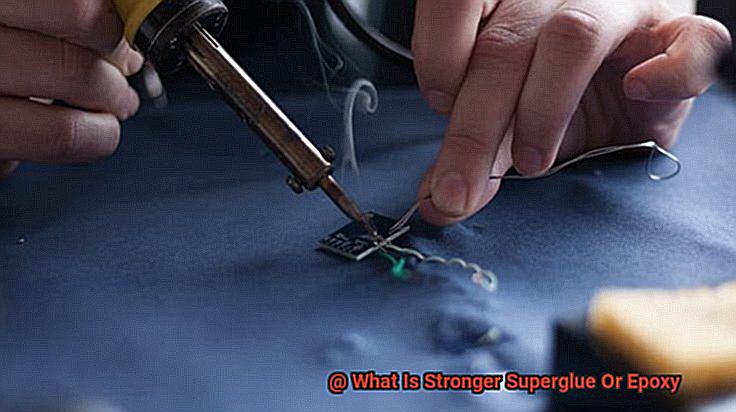
Epoxy, on the other hand, is a two-part adhesive that consists of a resin and a hardener. It’s known for its exceptional strength and durability, making it a popular choice for bonding metals, ceramics, wood, and even some plastics.
Epoxy can also withstand high temperatures and heavy loads without breaking down.
Comparing Strength: Superglue vs Epoxy
When it comes to bonding materials, selecting the right adhesive is crucial. Two popular options are superglue and epoxy. Superglue, also known as cyanoacrylate glue, is fast-drying and works by creating a chemical reaction with moisture in the air. On the other hand, epoxy consists of a resin and a hardener that create a strong chemical reaction when mixed together.
While both adhesives can create a strong bond, their strength varies depending on the application and materials being bonded. In general, epoxy tends to be stronger than superglue because of its ability to create a more durable and long-lasting bond.
Superglue is ideal for small-scale projects and repairs, such as fixing ceramic or glass objects. It’s perfect for bonding smooth surfaces quickly and with minimal mess. Superglue can dry in just a few seconds and dries clear, making it an excellent choice for transparent or translucent materials.
On the other hand, if you need to bond two heavy-duty materials together or require a long-lasting and durable bond, epoxy is likely the better choice. Epoxy’s chemical reaction creates a stronger bond that can withstand heavy stress and strain. It’s often used for larger projects such as repairing concrete or metal surfaces.
When deciding between superglue and epoxy, it’s crucial to consider the specific application and materials being bonded. Both adhesives have their strengths and weaknesses, so it’s essential to choose the one that best fits your needs.
Specialty Glues and Their Uses
There’s nothing worse than watching your hard work fall apart because you used the wrong adhesive. But fear not, as an expert in specialty glues and their uses, I’m here to share my knowledge about the different types of adhesives available and how they can benefit your projects.
Specialty glues are adhesives that are designed for specific purposes and materials. They’re formulated to provide specific properties such as strength, flexibility, and durability. There are four main types of specialty glues: cyanoacrylate (super glue), epoxy, polyurethane, and silicone.
Cyanoacrylate, also known as super glue, is a fast-drying adhesive that’s ideal for bonding non-porous materials such as metal, plastic, and glass. Its quick setting time and strong bonding capabilities make it a popular choice for DIY home projects and repairs.
Epoxy is a two-part adhesive that consists of a resin and hardener that must be mixed together prior to use. It’s known for its high strength and durability, making it ideal for bonding heavy-duty materials such as wood, metal, and concrete. Epoxy can also be used for filling gaps and cracks in surfaces.
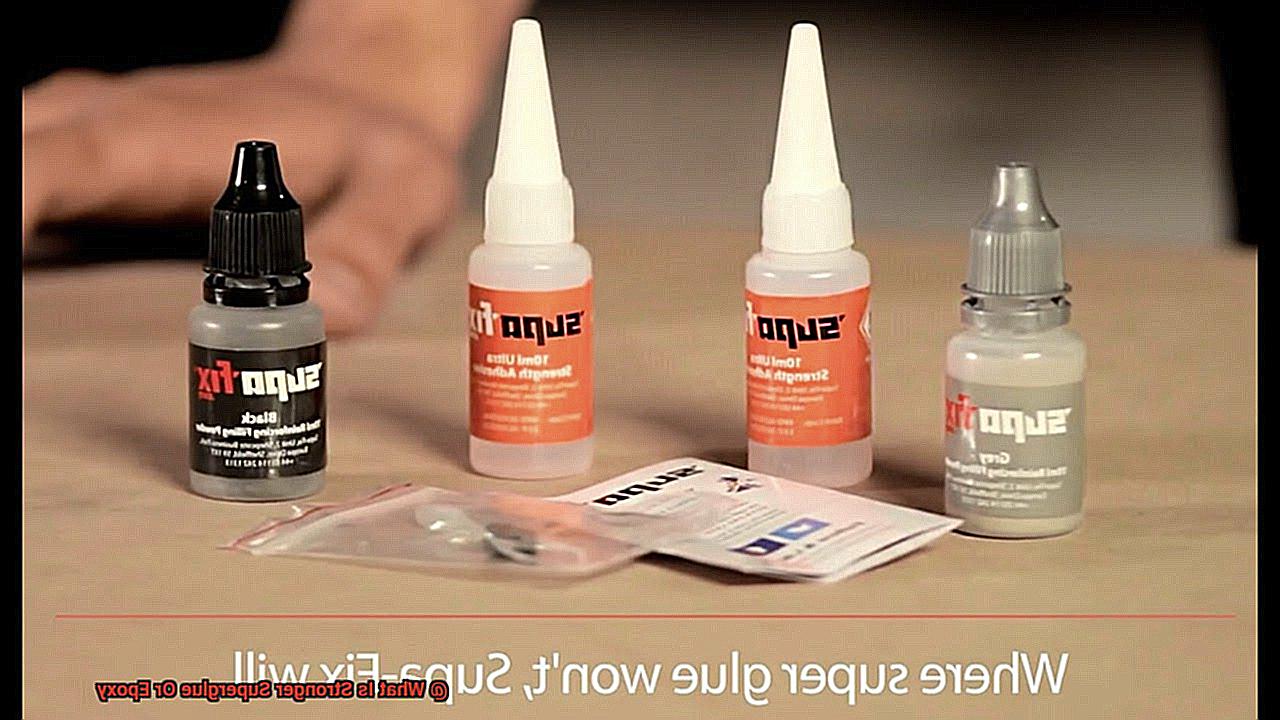
Polyurethane glue is a waterproof adhesive that’s perfect for outdoor applications. It has excellent bonding capabilities on a wide range of materials including wood, metal, and plastic. Polyurethane glue also has the ability to expand slightly when it dries, allowing it to fill gaps and create a stronger bond.
Silicone adhesive is a flexible adhesive that’s ideal for bonding materials that require movement or flexibility such as rubber or plastic. It has excellent resistance to temperature changes and can withstand extreme conditions such as high heat or cold temperatures.
Tips for Working with Superglue and Epoxy
Working with adhesives such as superglue and epoxy requires skill, precision, and safety measures. These adhesives are known for their strength and durability, but they can also be tricky to use. Here are some tips that can help you work with superglue and epoxy like a pro:
Clean and prepare surfaces
The first step to creating a strong bond is to ensure that the surfaces you plan to bond are clean and free of debris or oils. Even a tiny speck of dust or oil can weaken the bond. Use a degreaser or rubbing alcohol to remove any contaminants, and ensure that the surfaces are completely dry before applying the adhesive.
Use the right amount
Applying too much or too little adhesive can affect the strength of the bond. Follow the instructions on the packaging carefully to ensure that you are using the correct amount. Remember, in the case of superglue, a little goes a long way.
Work quickly
Both superglue and epoxy dry quickly, so it is crucial to work efficiently to ensure that the bond is created before the adhesive sets. This may mean preparing all surfaces beforehand and having everything ready to go before applying the adhesive.
Use clamps or weights
Depending on your project, using clamps or weights can help hold the surfaces together while the adhesive dries. This will help ensure that a strong bond is created and that the surfaces do not shift or move during the drying process.
Wear protective gear
Safety should always be a top priority when working with superglue and epoxy. These adhesives can be dangerous if they come into contact with skin or eyes. Make sure to wear gloves and eye protection when working with these adhesives to prevent any accidents or injuries.
When working with superglue, apply it sparingly, and avoid touching it with your fingers as it can stick to skin very quickly. Also, make sure to apply pressure to the objects being glued together for at least 30 seconds to ensure a strong bond.
When it comes to epoxy, mixing the two components thoroughly is crucial. A poorly mixed epoxy can result in a weak bond. To ensure a strong bond, use a mixing tool or stirrer and mix the components thoroughly for the recommended time.
In case of accidental contact with skin or other surfaces, both superglue and epoxy can be challenging to remove. If you get them on your skin, try using acetone or nail polish remover to dissolve the adhesive. For surfaces, there are specialized solvents available that can help remove the adhesive without damaging the material underneath.
Common Mistakes to Avoid When Using Glues
Using glue can be a tricky business. If you’re not careful, you may end up with weak or ineffective bonds. But fear not, my friend. As an expert on the subject, I’m here to give you some tips on how to avoid common mistakes and achieve strong, long-lasting bonds.
First and foremost, it’s crucial to use the right type of glue for the job at hand. Super glue and epoxy are two very different types of adhesives with unique strengths and weaknesses. Using the wrong type of glue will only lead to disappointment, so make sure you know what you need before starting your project.
Another mistake people often make is not properly preparing surfaces before applying the glue. Surfaces should be clean, dry, and free of any debris or contaminants that may interfere with the bond. Additionally, roughing up the surface with sandpaper or a wire brush can improve the adhesive’s ability to grip onto it.
Using too much glue is another common mistake that can actually weaken the bond instead of making it stronger. Always follow the manufacturer’s instructions regarding how much glue to use, and avoid over-applying or smearing excess glue around. Remember, less is sometimes more.
Lastly, it’s important to give the glue enough time to fully cure before handling or using the bonded item. Rushing this process can result in a weaker bond that may break or come apart easily. Be patient and wait for the glue to fully dry and set according to the manufacturer’s instructions.
To summarize, here’s a quick checklist of things to keep in mind when using glue:
- Use the right type of glue for the job
- Prepare surfaces properly by cleaning and roughing them up if necessary
- Use the recommended amount of glue (less is sometimes more.)
- Allow enough time for the glue to fully cure
Conclusion
In conclusion, when it comes to strength, epoxy reigns supreme over superglue.
Whether you’re tackling a DIY home improvement project or working on a professional construction job, investing in high-quality epoxy will give you the peace of mind that your materials are securely bonded together.

